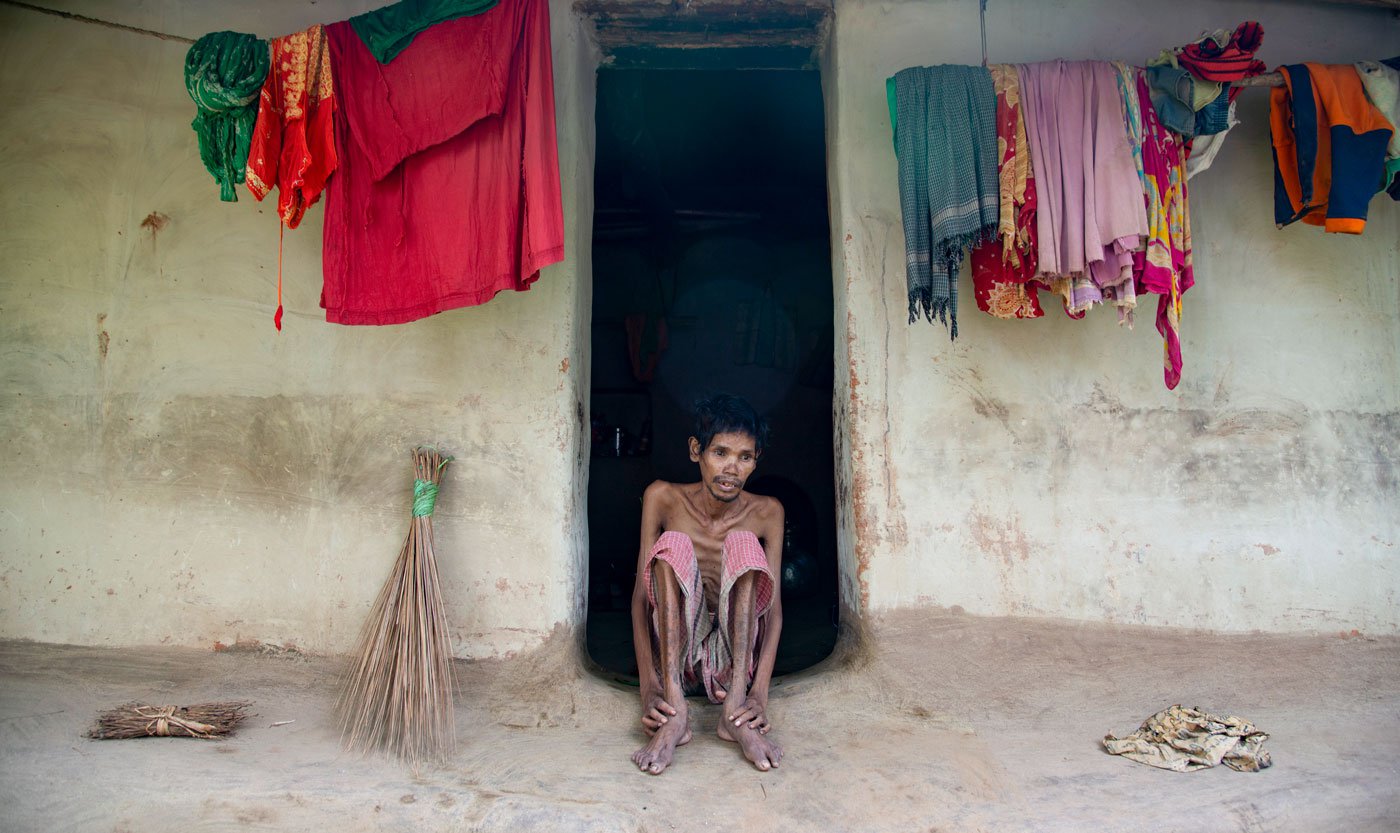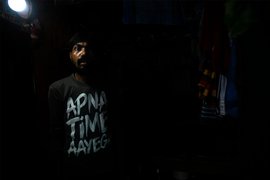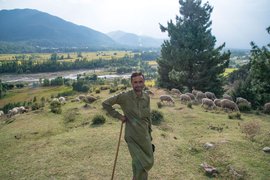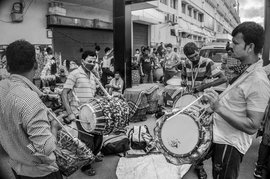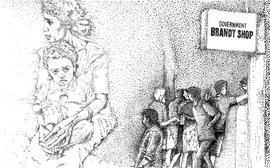“Many things, including hunger, are easier to forget with alcohol,” says Rabindra Bhuiya, a resident of Singdhui village in Jhargram district.
In his fifties, Bhuiya is a Sabar Adivasi (listed as Savar in West Bengal). From the Munda tribal community, Sabars live in the eastern parts of India and also go by the name of Saora, Sora, Shabar and Suris. Lodha Savar are predominant in West Medinipur (undivided), and Kharia Savar reside largely in Purulia, Bankura, and West Medinipur (undivided).
Mahasweta Devi’s
The Book of the Hunter
(first published in Bengali as
Byadhkhanda
in 1994), depicts the extreme poverty and marginalisation of this community. Decades later, not much has changed and a 2020 report
Living World of the Adivasis of West Bengal
shows, “67 per cent of the villages surveyed reported suffering from hunger.”
The community were labelled ‘criminal tribes’ by the British from the latter half of the 18th century till 1952 when they were denotified. Traditionally hunters, they are adept at collecting fruits, leaves and roots, and also hunting animals in the forest. After Independence, some were given land to cultivate, but most of it was stony and barren ground, so they ended up working as migrant labourers. Despite the denotification, the stigma remains, and they continue to live at the mercy of the local police and forest service who put curbs on their movement.
With few earning opportunities, hunger is palpable among the Sabar community of West Medinipur and Jhargram districts. Many like Bhuiya dowse their hunger with alcohol or, “we eat
panta bhat
[fermented rice] thrice a day. We live on that,” says Bankim Mallick. The 55-year-old resident of Tapoban village, Mallick is referring to the public distribution system (PDS) that provides five kilograms of rice a month to each member of a household. “Salt or oil is a luxury.” He is eating
panta bhaat,
seated in front of his dilapidated house.
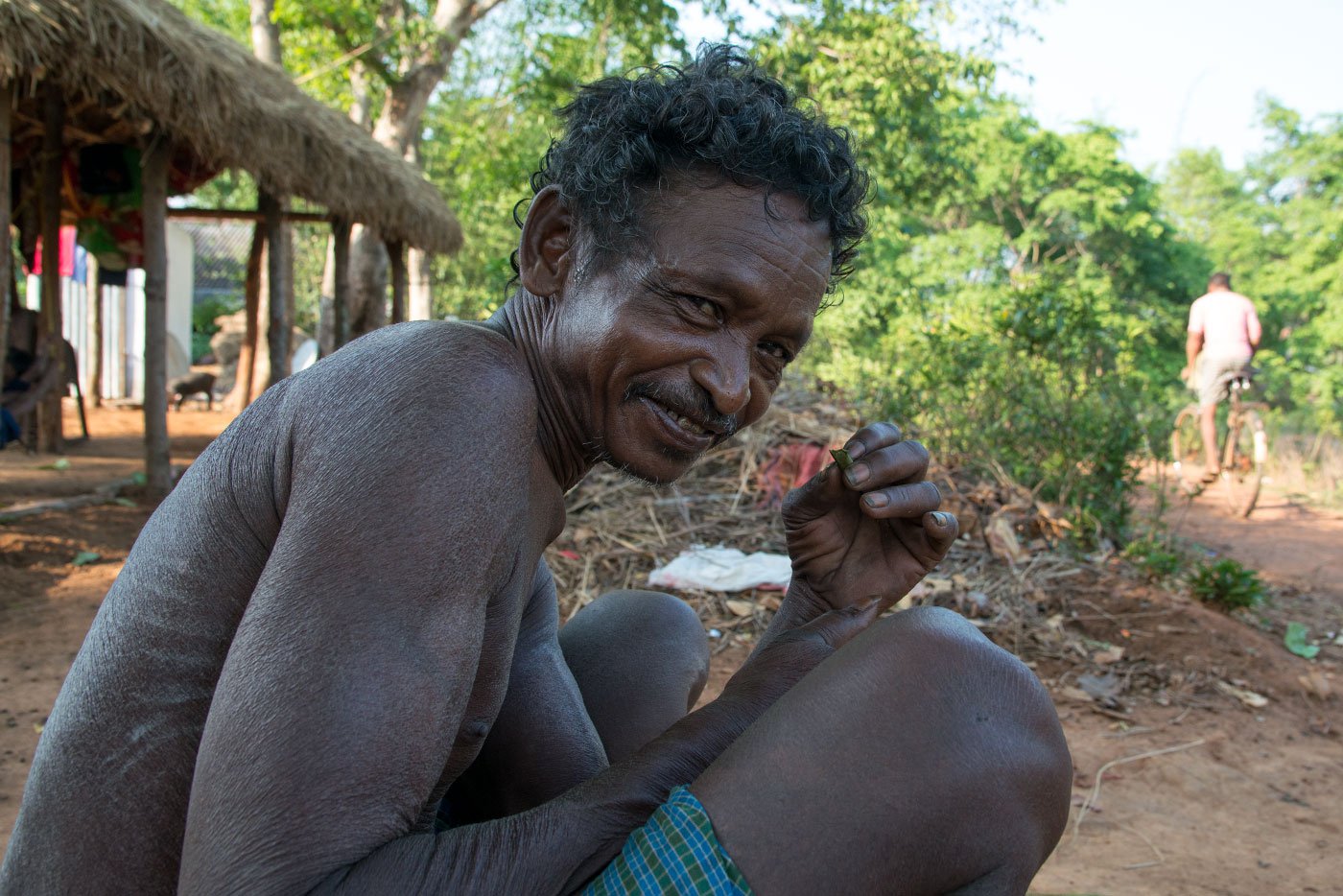
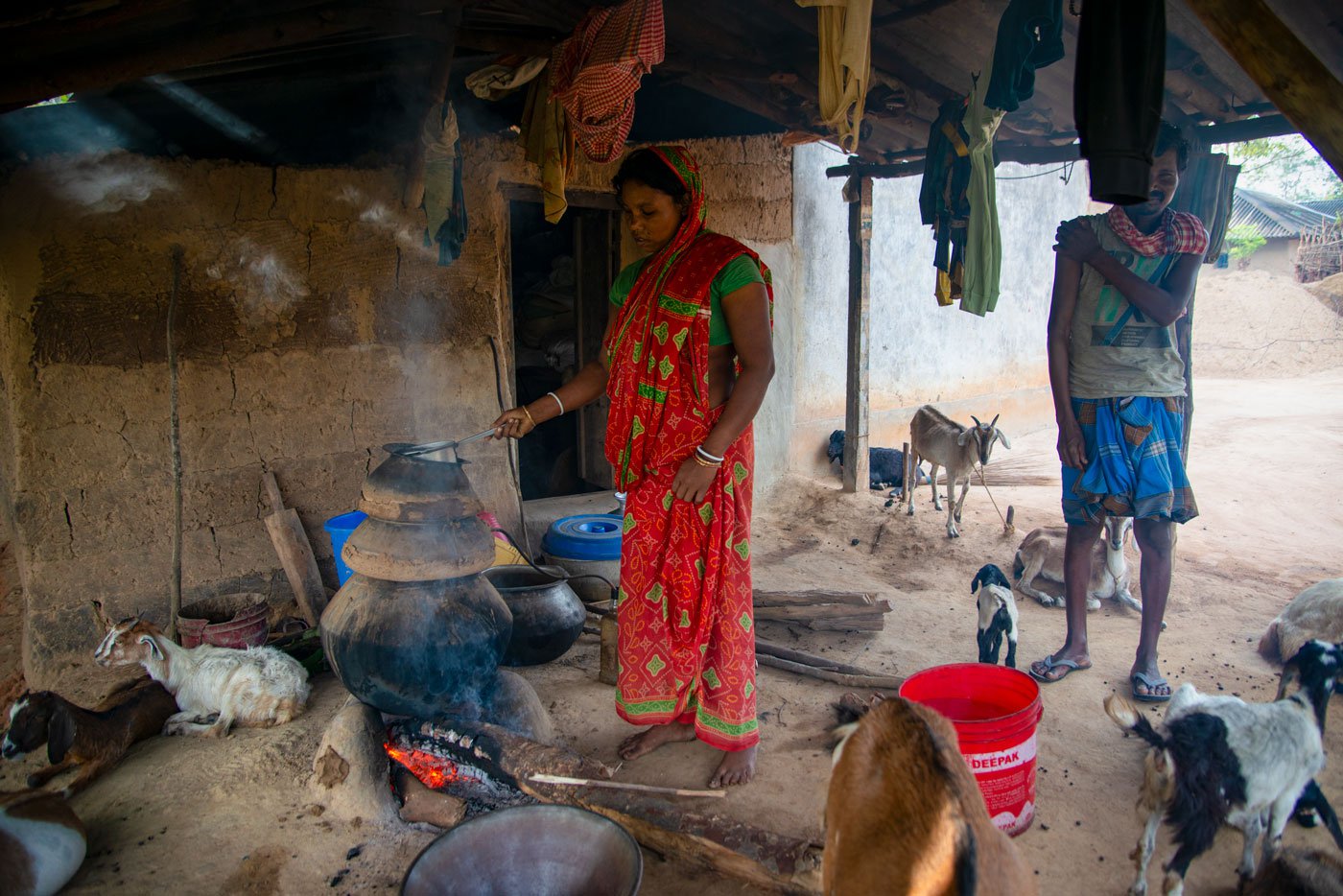
Rabindra Bhuiya (left) is a resident of Singdhui village, Jhargram district where many Sabar Adivasi families live
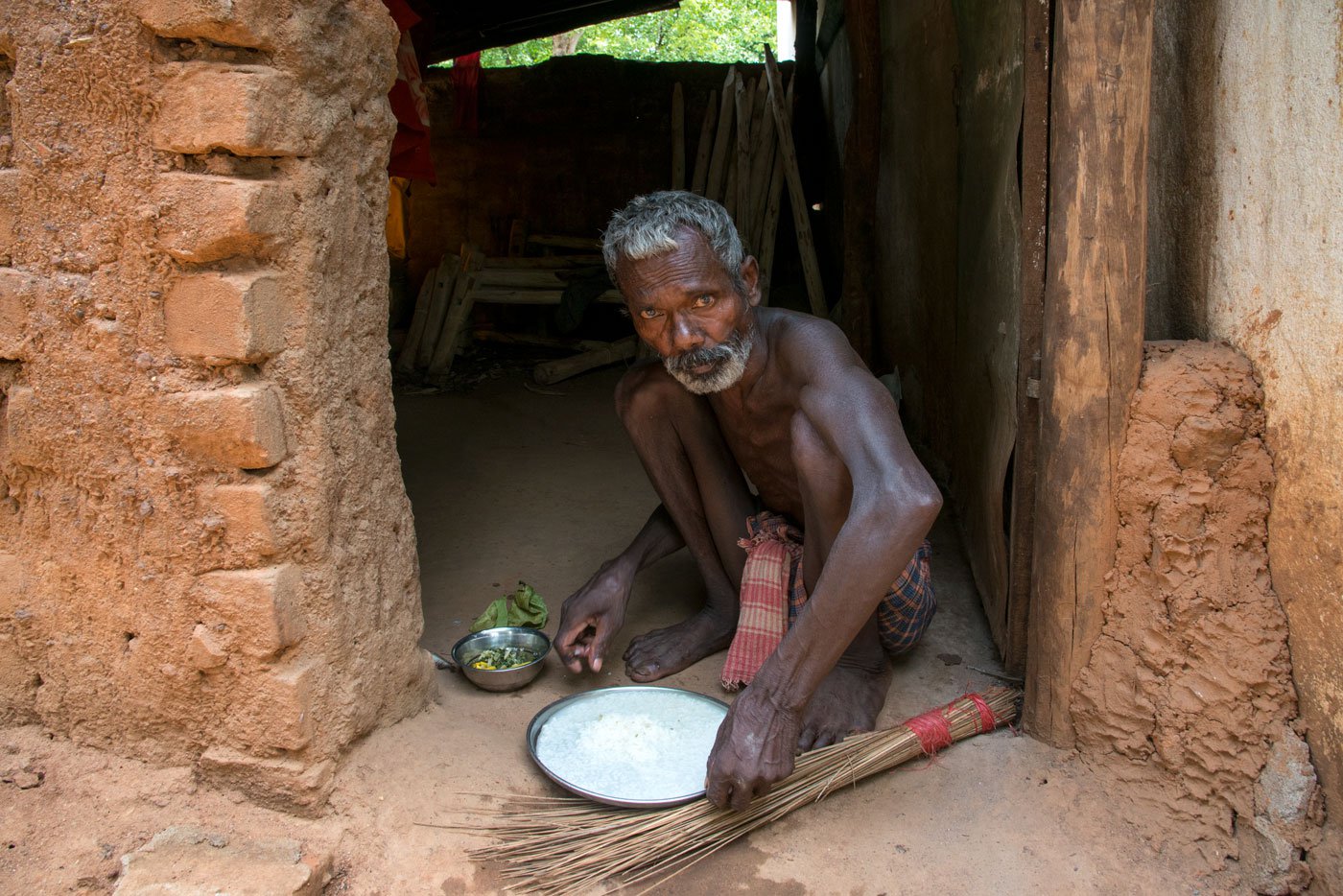
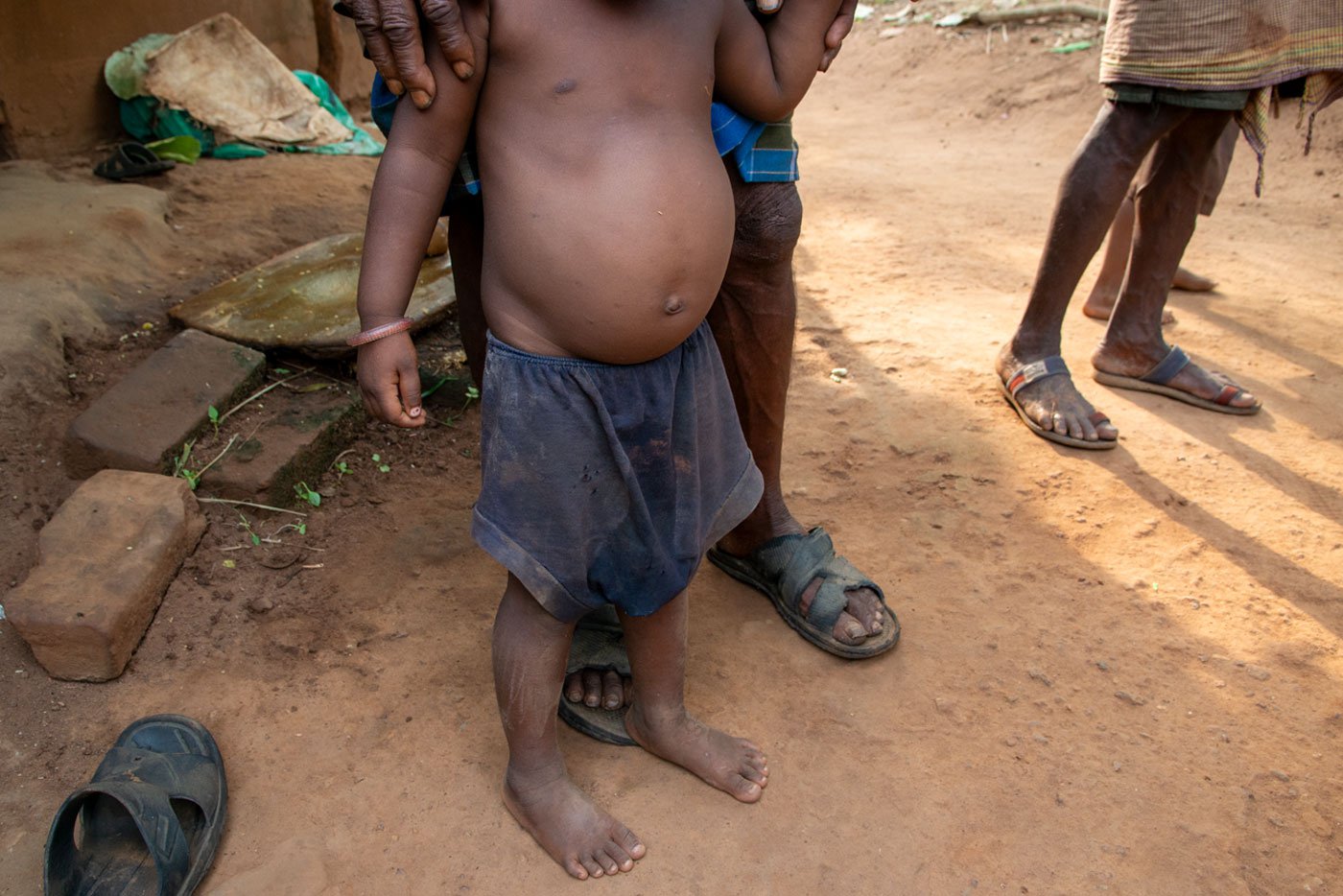
A resident of Tapoban village, Bankim Mallick (left) is eating panta bhaat (fermented rice), a staple for many families who cannot afford to buy food. The fear of wild animals has made them wary of finding food in the forest. A child (right) exhibiting symptoms of malnutrition
Through the year the Sabars rely on the bounty of the forests to supplement their meagre rations. During the months of summer – Baisakh, Jaisthya and then monsoon – Ashadha , the community gathers forest fruits and roots and hunts baby birds, snakes, gosaps (Bengal Monitor lizard), frogs and snails. As well as field frogs, large snails, little fish and crabs.
Later in
Sravana, Bhadra
and
Ashwin
, it is fish from riverbeds; during
Kartika, Agrahayana
and
Paush
– the months that follow, the community scoops out paddy stored by rats in their holes, after first catching them in the field. During winter months of
Magh
and later spring –
Falgun
and
Chaitra
, they hunt small animals and forage for woodland fruits, and
chak
(honeycombs).
But like other Adivasi communities, they are finding it difficult to access forests as they say wild animals forage aggressively for food and so they fear for their lives when they enter.
“We do not leave the village after dusk, even if someone falls sick. Some of the elephant herds do not even move. It seems they have an Aadhaar card [to show residence] here,” says Joga Mallick, 52, half in jest.
Sukra Nayak is a Sabar from Tapoban village and in his sixties. He says the presence of elephants has made it, “very scary here. Elephants are everywhere and they also become very aggressive. They are not only attacking people, but they are also destroying paddy fields, banana trees, and our homes too.”
But his neighbour Jatin Bhakta, also a resident of Benashuli village points out, “If we do not go to the jungle, what are we going to eat? There have been many days where we survive on one meal of
panta bhaat
.”
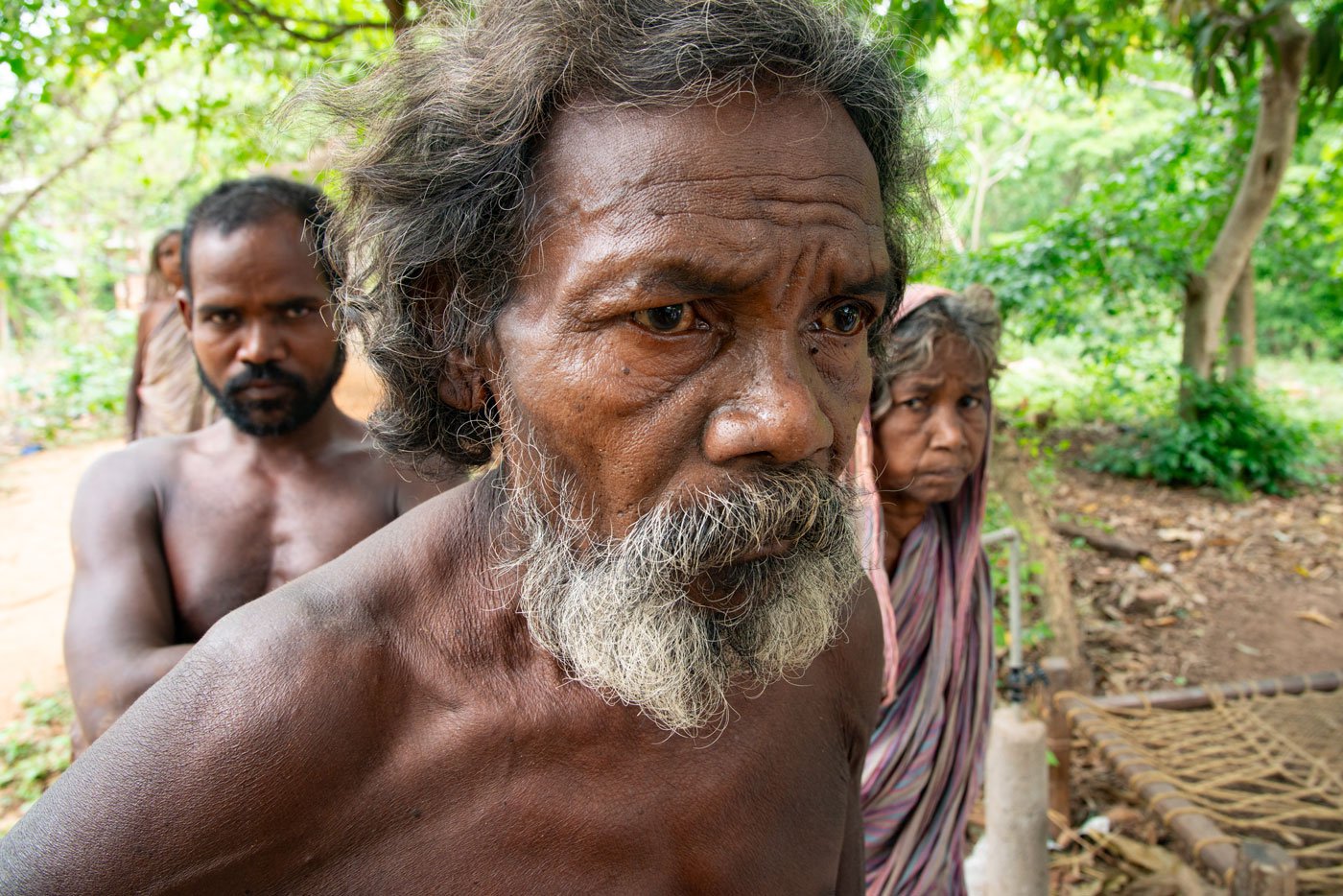
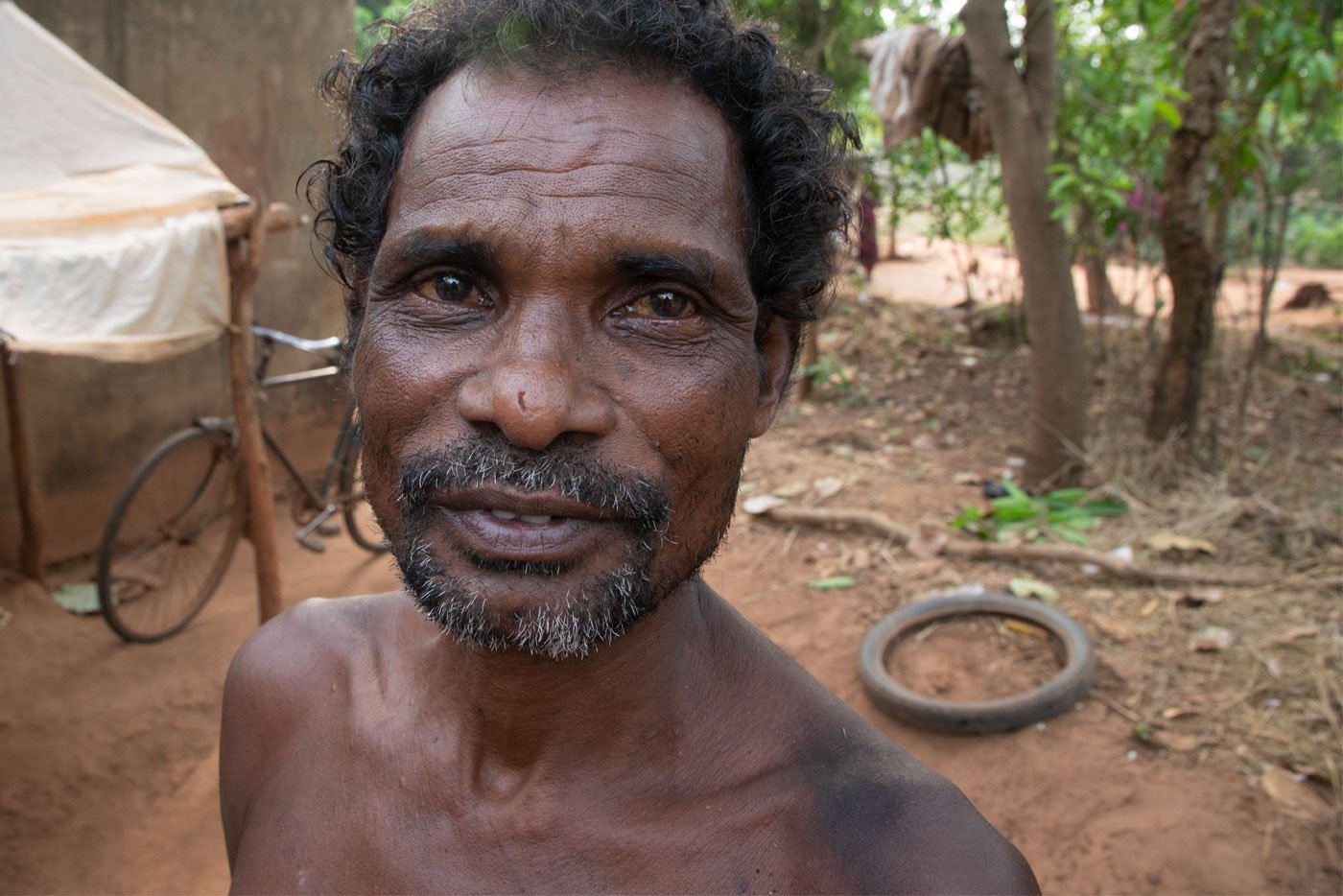
Joga Mallick (left), a Sabar Adivasi from Tapoban village has many health-related issues including diabetes. ' If we do not go to the jungle, what are we going to eat? ' says Jatin Bhakta (right) from Benashuli
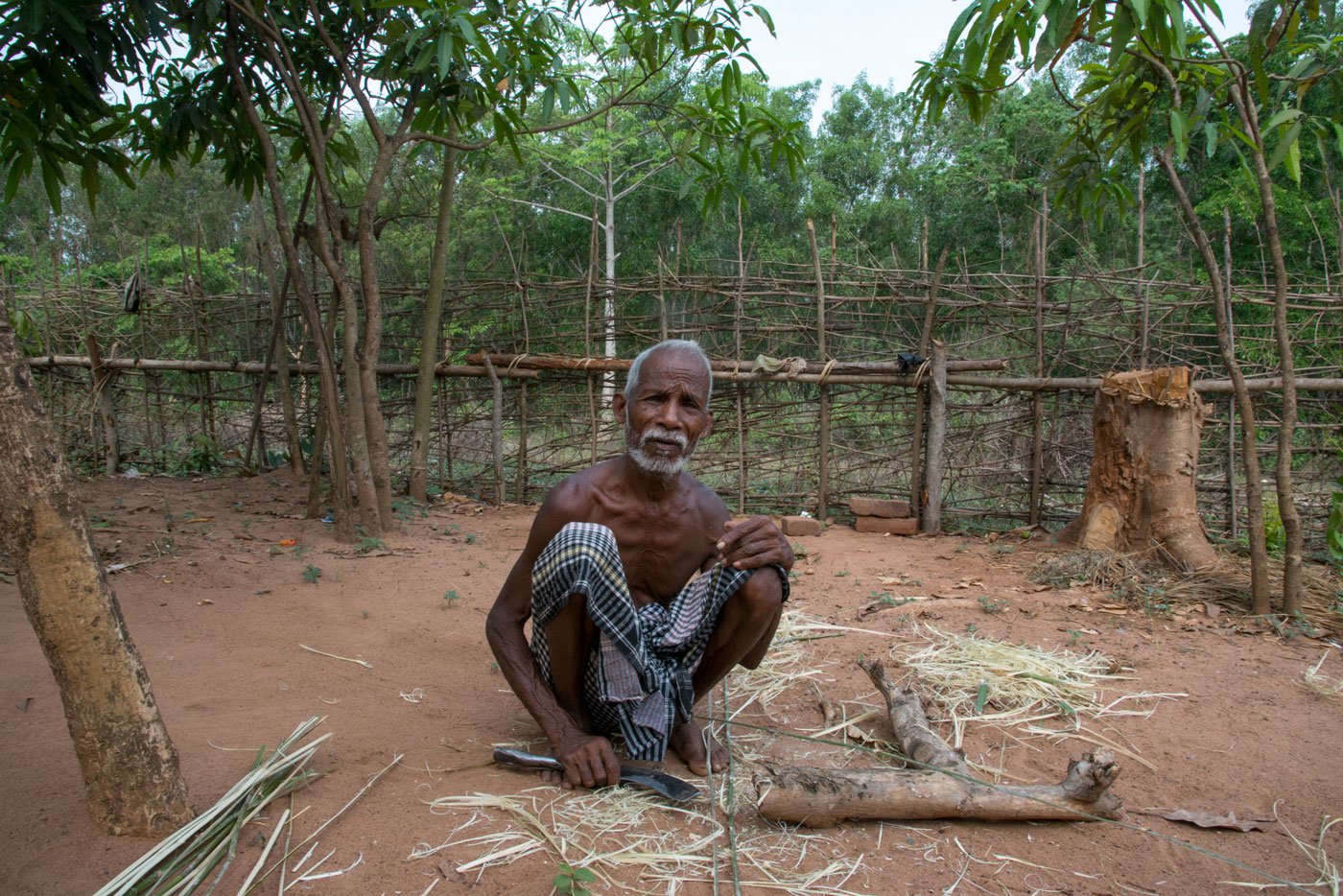
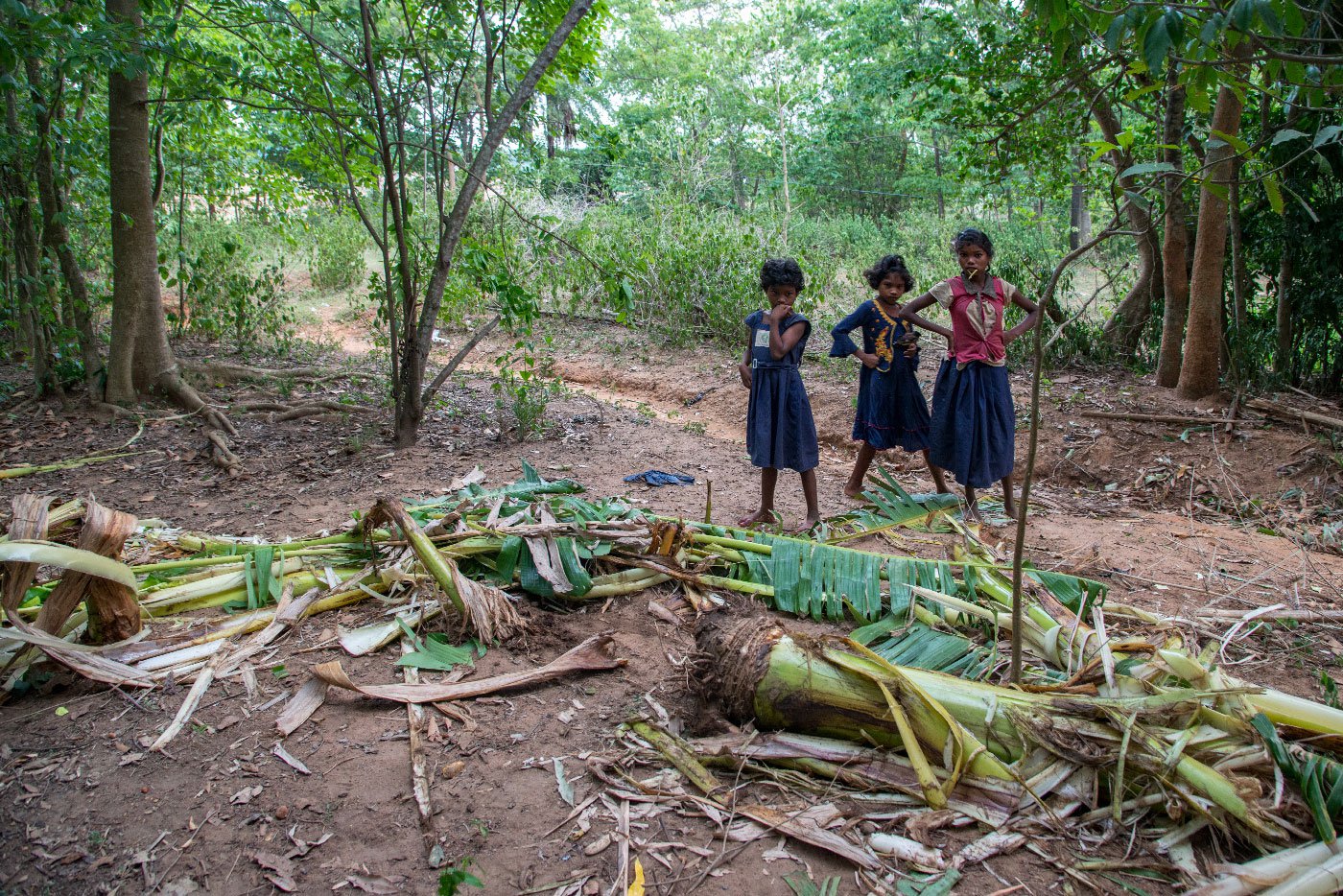
Sukra Nayak (left) from Benashuli says, 'I cannot sleep at night because elephants pass by. My house is at the end of the village. It's very risky.' The elephants often come to villages in search of food. A banana garden (right) destroyed by elephants
The compromised diets of Sabars make them susceptible to diseases like tuberculosis. Sarathi Mallik is a TB patient and has been for medical camps but does not want to attend any more. The 30-year-old resident of Benashuli village explains why: “I am the only woman in my family. If I get admitted to the hospital, who will do household work? Who will go to the jungle to collect leaves with my husband?” And then travelling for check-ups to hospital is expensive, “each journey one-way can cost 50 to 80 rupees. We cannot afford that.”
The major earning of Sabar families comes from gathering leaves of the
sal
(
Shorea robusta
) tree and selling them, an arduous task.
Sal
is a hardwood tree and an important source of timber in India. Dilip Mohanty, a buyer of
sal
leaves from Odisha who regularly visits the market says, “This year's supply of leaves has gone down drastically. The Sabar community are now afraid of going into the jungle because of elephants.’
Konda Bhakta, Jatin’s neighbour, agrees, saying this is fraught with risk. “We generally make a group and go together. It's a very risky affair, there are snakes and elephants. We go around 6 a.m. and come back by afternoon.”
The leaves are collected and dried and then, “we carry them on a cycle and to the nearest
haat
, held weekly on Saturday. The buyers from Odisha come there and they pay us Rs. 60 for a bundle of 1,000 leaves. If I sell four bundles in a week, I can earn Rs. 240,” says Jatin Bhokta. “That is the average earning of most families here.”
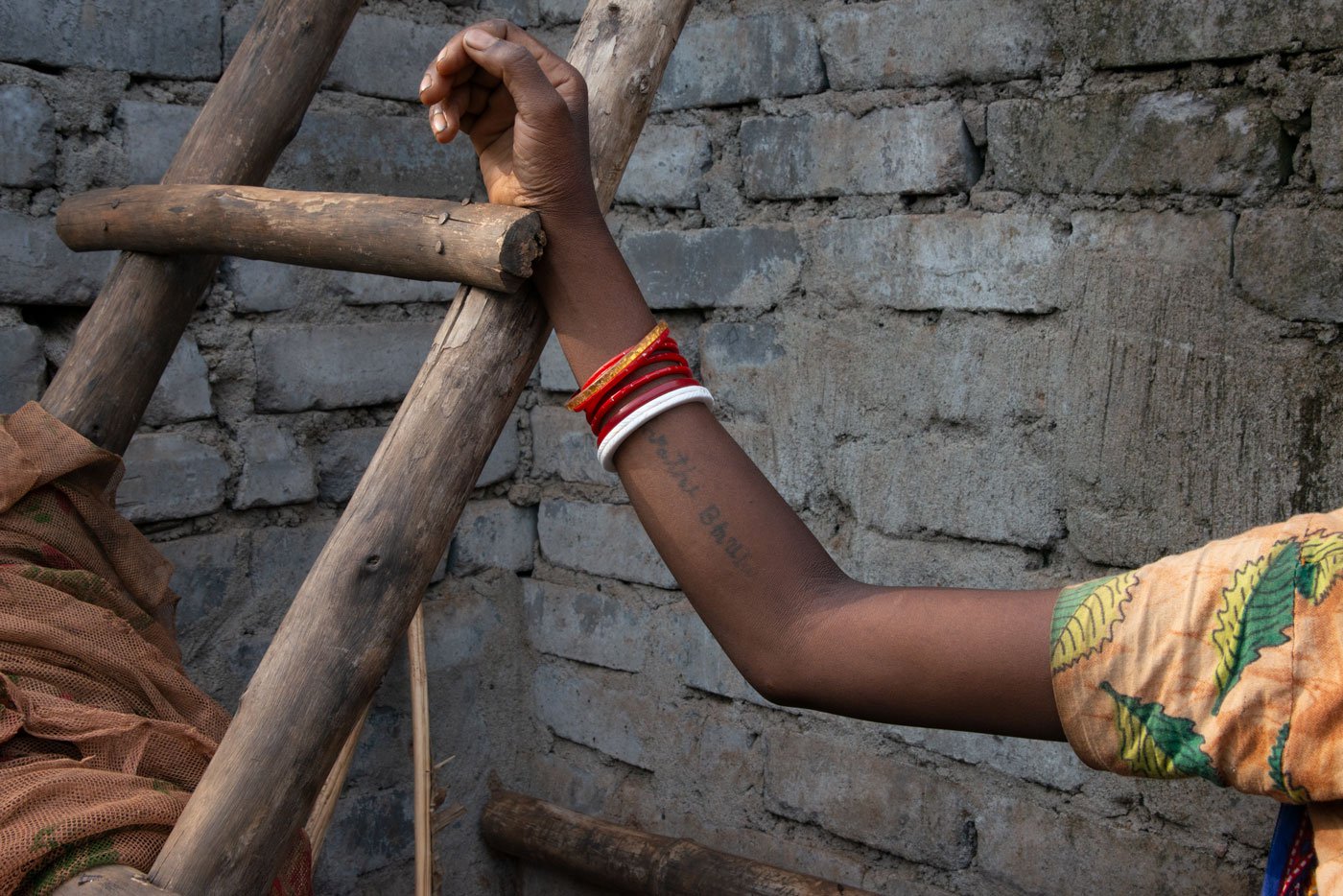
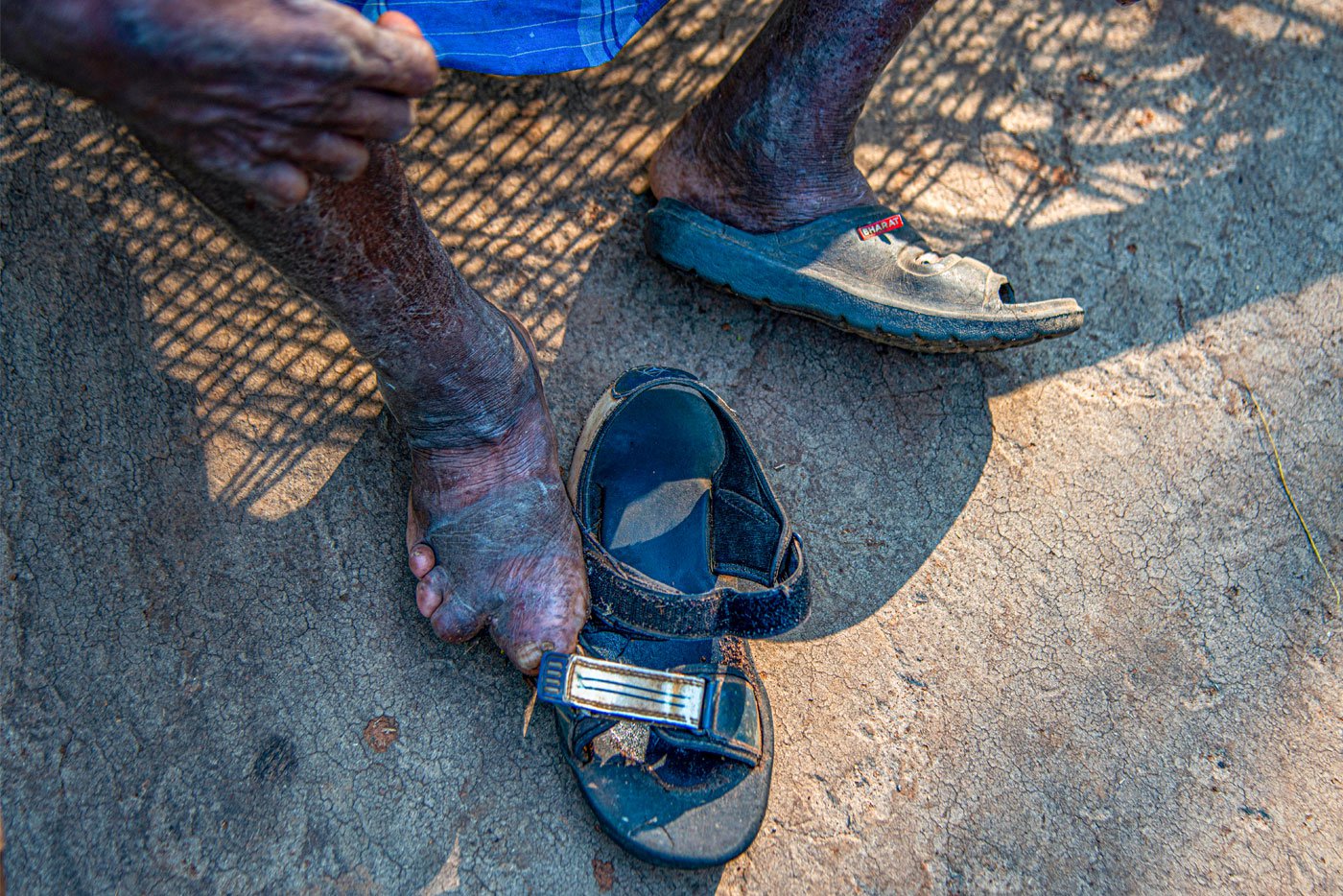
Left: Sarathi Mallik of Benashuli was diagnosed with tuberculosis in November 2022. She is under medication and cannot work long hours. Right: Sabar Mallick is a resident of Singdhui and in the advanced stages of leprosy. He says the state offered no treatment for it
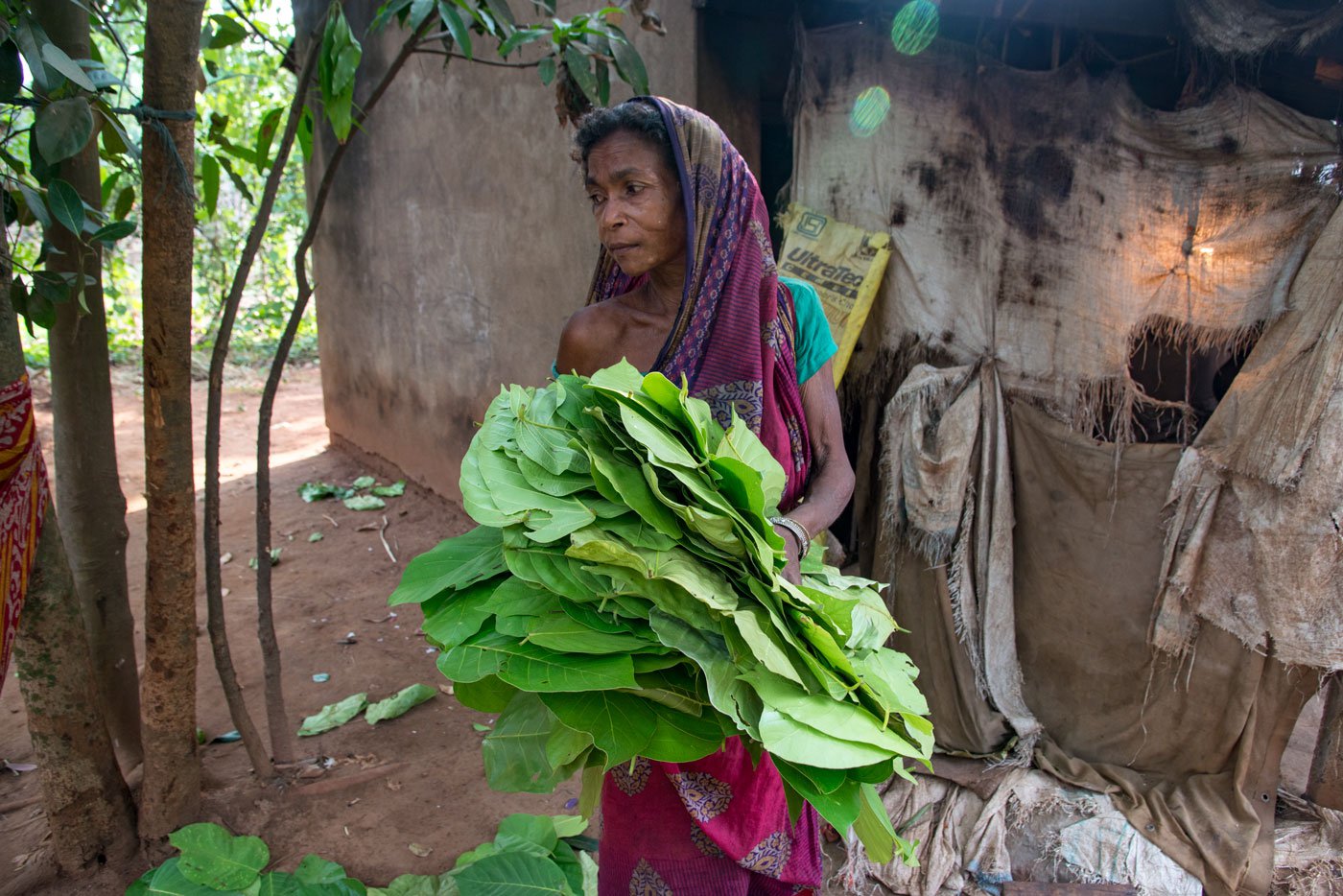
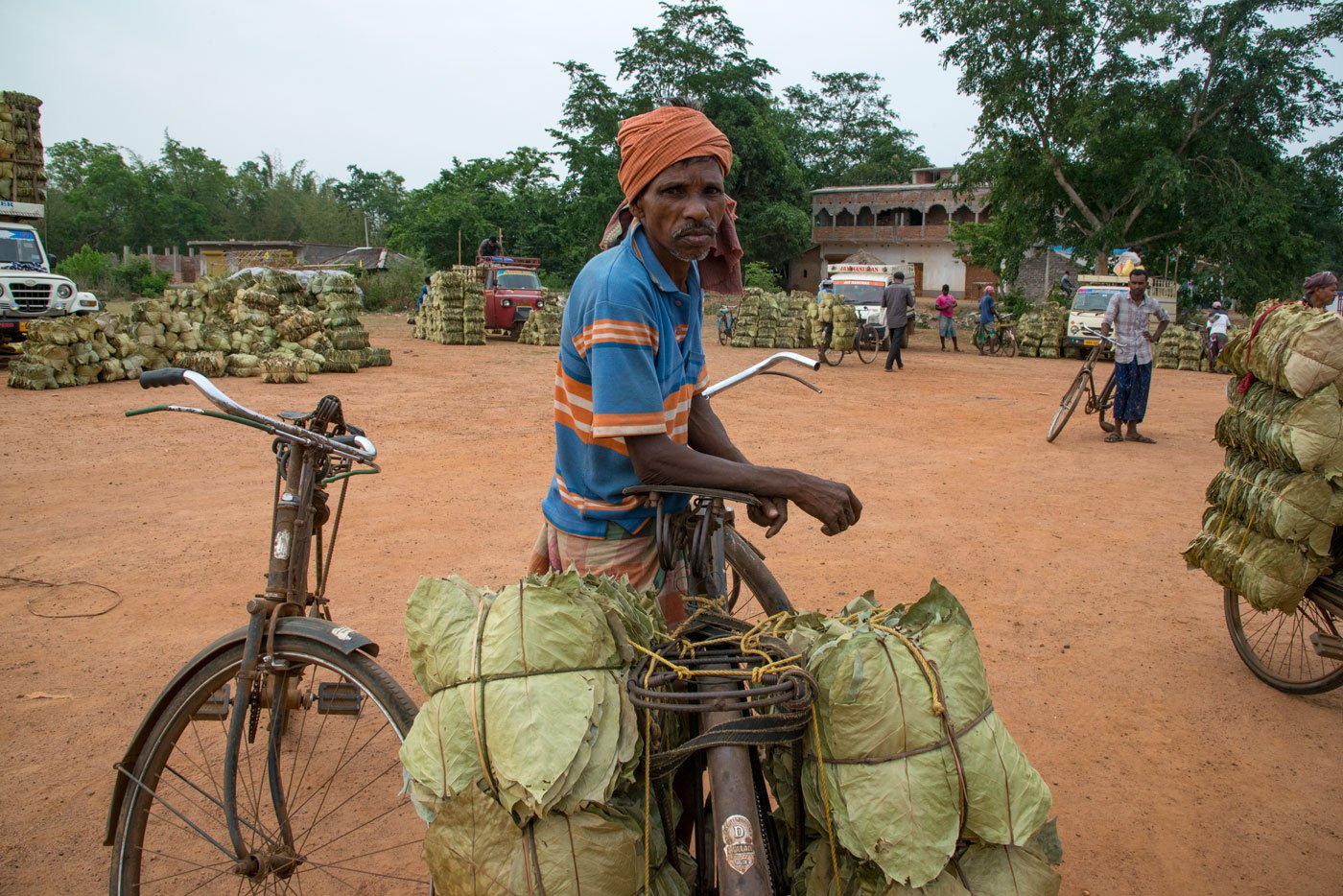
Left: Champa Mallick of Benashuli with the sal leaves she has collected at her home, for sale in the local weekly market. Right: Suben Bhakta from the same village brings the sal leaves to the market
The state has initiated housing for the community under the Pradhan Mantri Awas Yojana (PMAY) scheme. But Sabitri Mallick, 40, says, “we can't live there.” The concrete homes with asbestos roofing are unbearable when routine summer temperatures touch 43 degrees Celsius. “From March to June when the temperatures are high, how are we supposed to live here?”
There are a few private primary schools in villages like Benashuli and Tapoban set up by Kajla Janakalyan Samiti (KJKS), an NGO working to raise living standards in the community. Literacy is 40 per cent, well below the state and national average; almost a third of young Adivasis in this region are not enrolled in [middle and higher secondary] schools, says this 2020
report
. It also notes that students drop out of school due to factors such as caste-based assaults, distance from school, inability to bear educational expenses and obligations to get employed.
“When the community does not have proper earnings, sending children to school is a luxury,” says Swapan Jana who heads KJKS.
As is accessing healthcare, adds Pallavi Sengupta. “It's difficult for them to take X-rays because there are no primary healthcare camps nearby. So, they rely on conventional [traditional] healers,” says Sengupta who works with German Doctors, a charitable organisation that offers medical services to Adivasis in the area. Snake bites are also common in the area and here too, traditional healers take over as there are inadequate medical facilities.
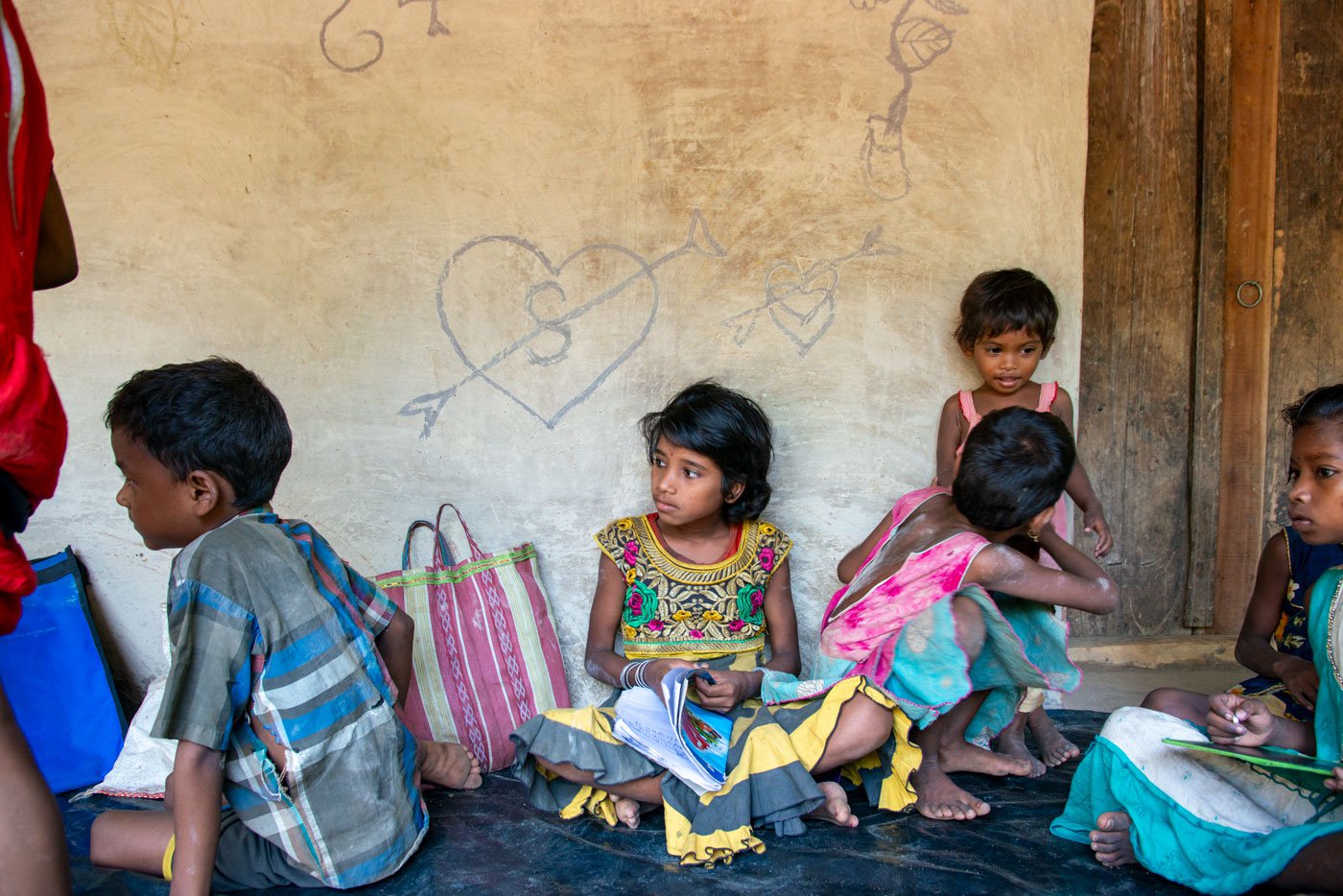
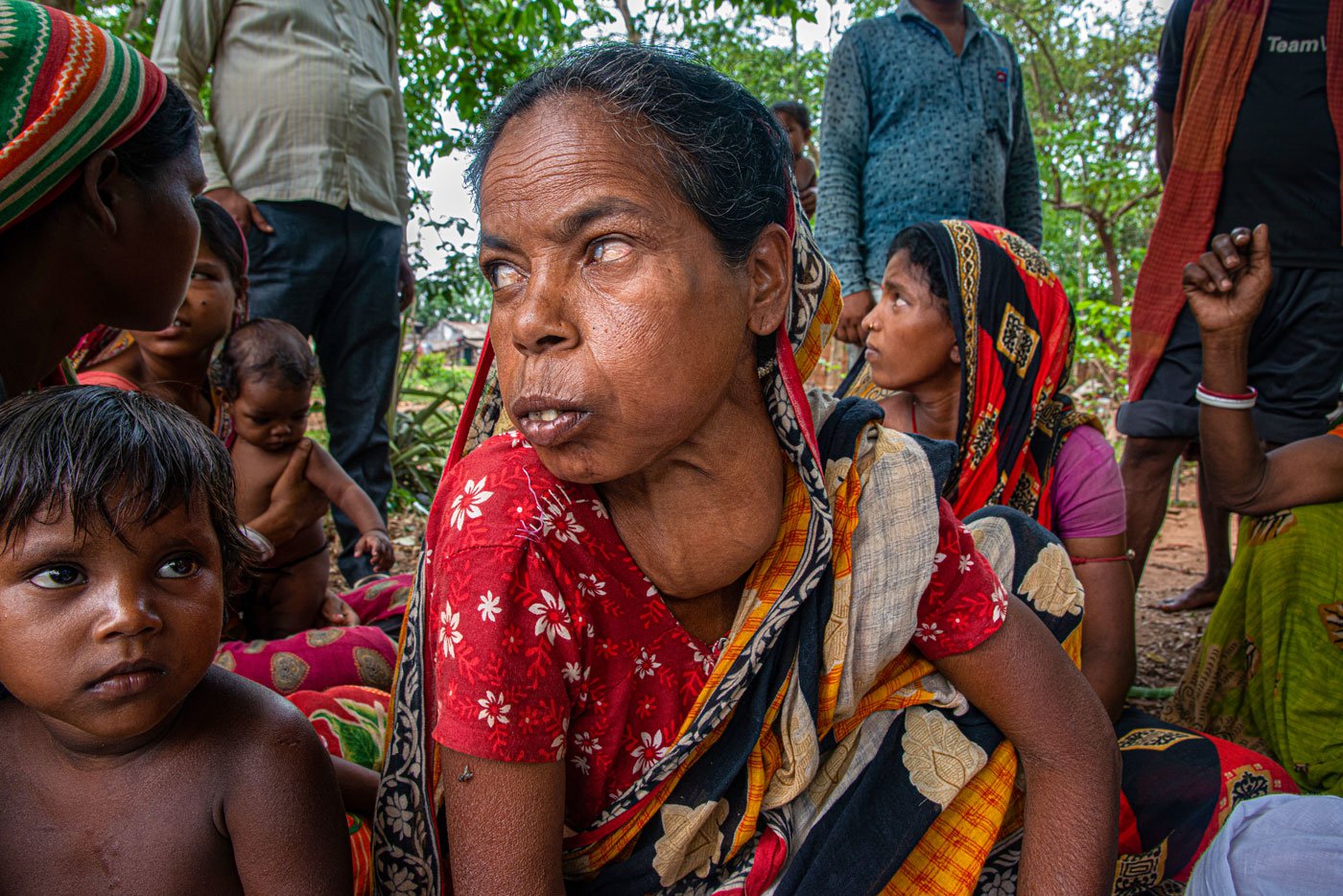
A school in Tapoban village started by the Janakalyan Samiti for Sabar children. Right: Behula Nayak is deficient in iodine and has developed goitre, a common occurance among Sabar women in Benashuli
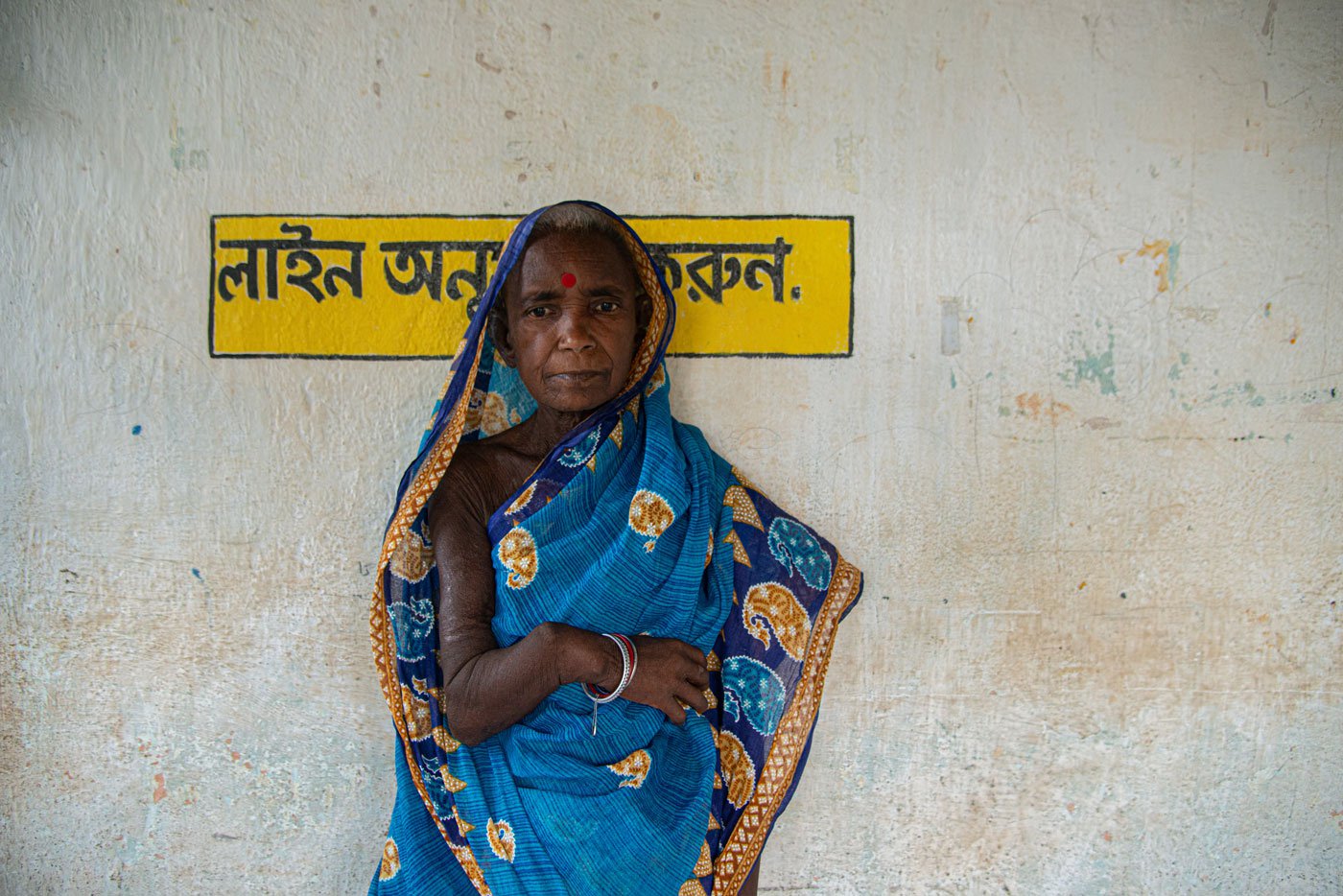
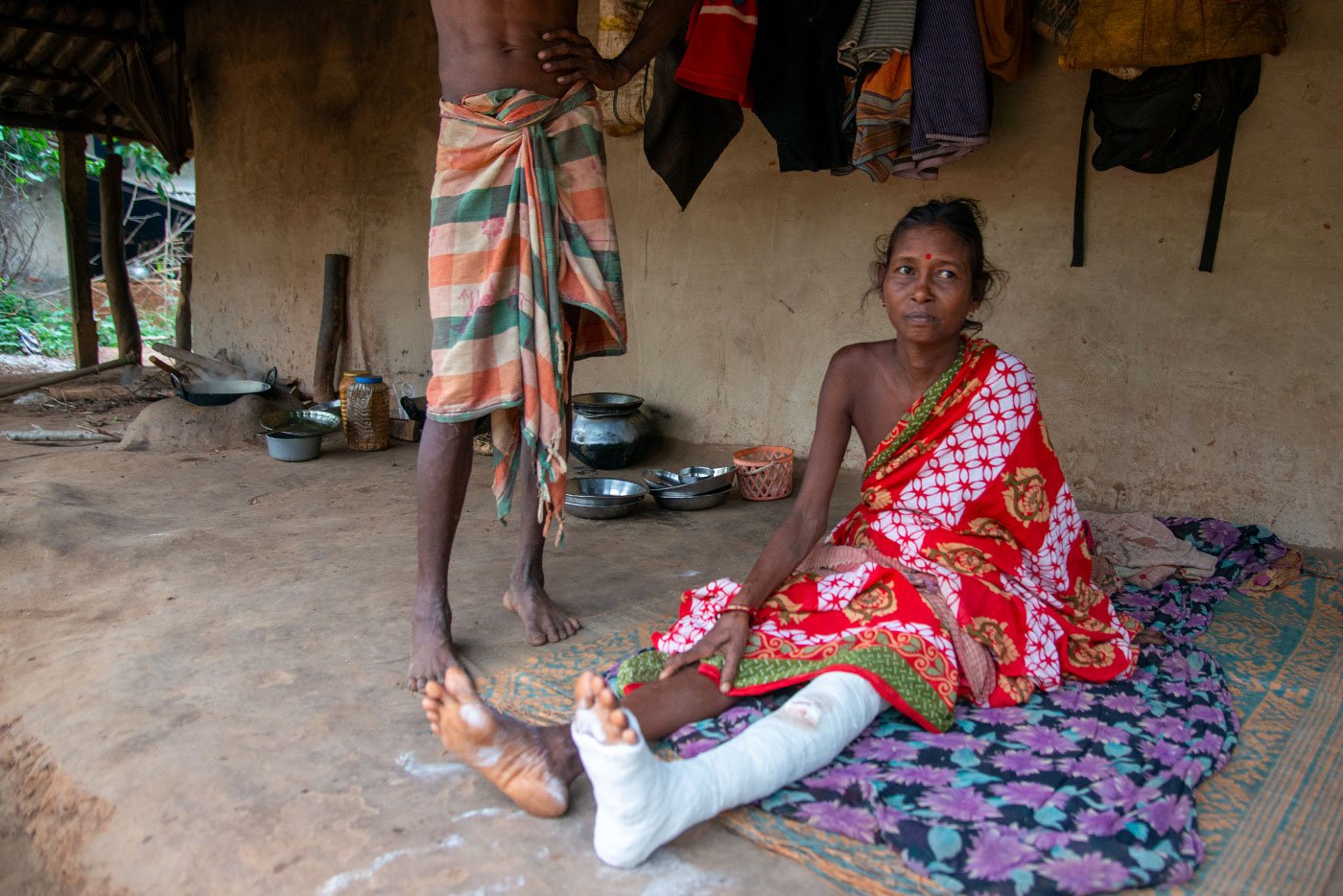
Kanak Kotal's hand (left) has become permanently deformed as she could not get medical help when she broke it. Her village, Singdhui, has little access to doctors and healthcare. Also true of Benashuli, where Kuni Bhakta (right) broke her leg, and now she is not sure when she will be able to walk again. Her husband Suben Bhakta says, they spent Rs. 8,000 on her treatment
Despite numbering just over 40,000 in West Bengal ( Statistical Profile of Scheduled Tribes in India, 2013), the Sabars continue to live on the edge of hunger.
In 2004, five persons in the Sabar village of Medinipur district, now Jhargram district, died after several months of starvation, leading to a furore in the national media. Twenty years later, not much has changed: there is overriding hunger, and lack of access to education and healthcare. Human-animal conflicts are frequent as the hamlets are situated in dense forests.
Given their dire condition, when residents quip about alcohol being a substitute for food, it is not said lightly. Rabindra Bhuiya asks this reporter, “If my breath has an alcoholic odour, will you scold me?”
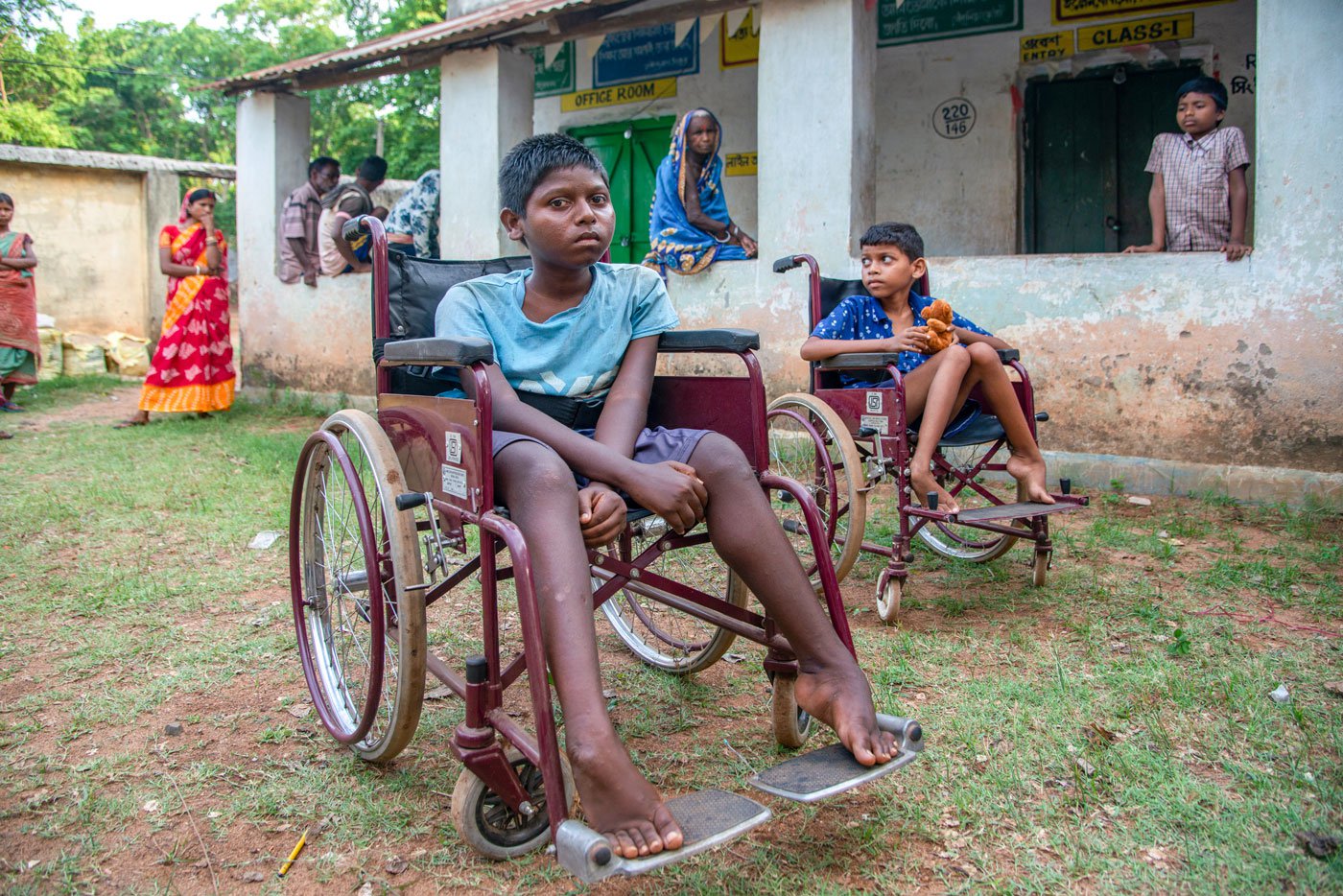
Parameswar Besra and Maheswar Beshra from Singdhui are in wheelchairs. The brothers were born healthy but lost their ability to walk over time. They could not get the help they needed as healthcare facilities are far, and the family's precarious financial condition did not allow it
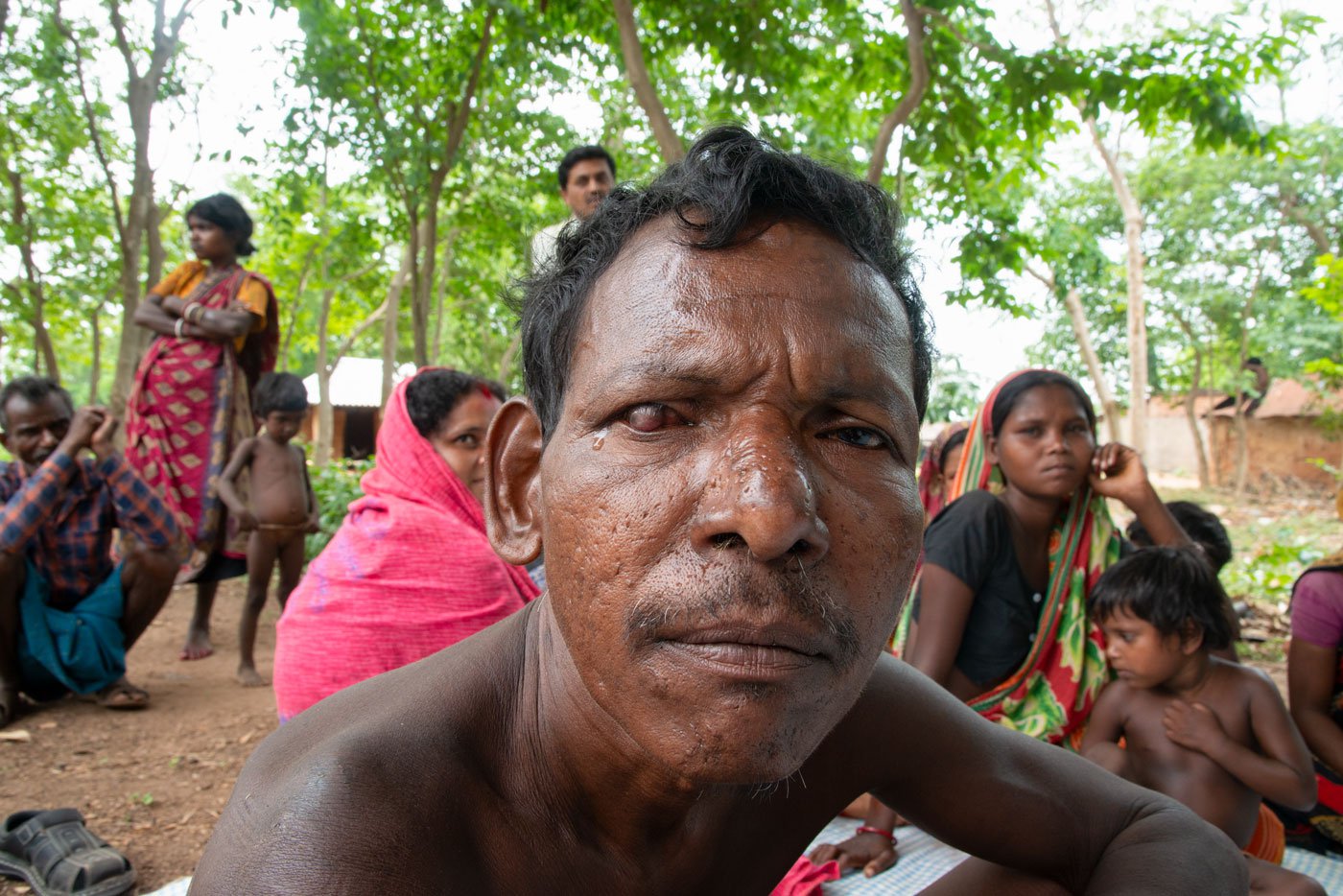
Madan Bhakta of Tapoban village has a rare eye disease. A local unlicensed doctor treated him wrongly, and as a result Bhakta lost his vision
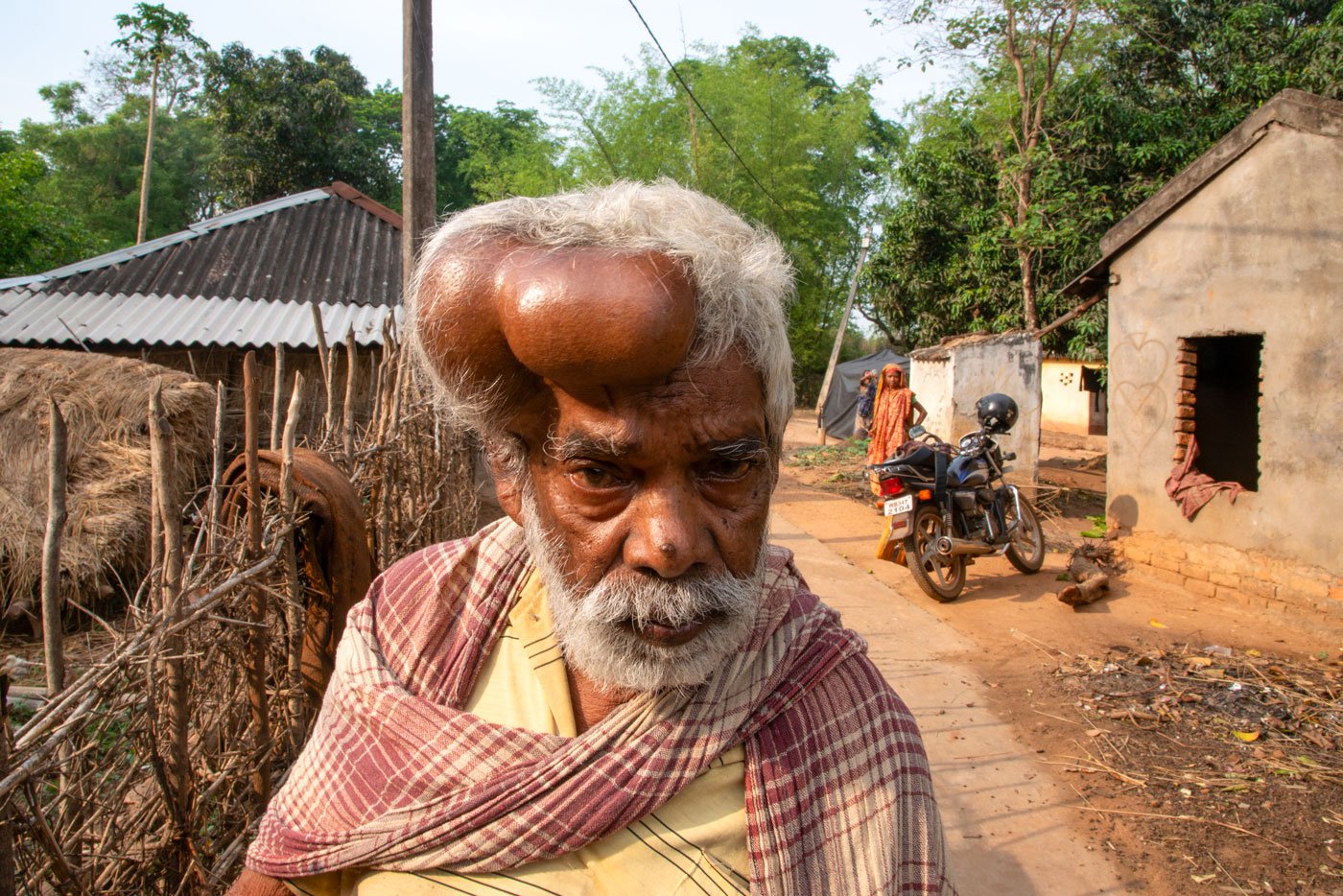
Konda Bhakta from Tapoban shows his tumour. 'First it was a small tumour. I ignored it. Then it became big. I wanted to go to the hospital but could not as they are located very far in Jhargram town. I do not have that much money, so I never had a proper treatment'
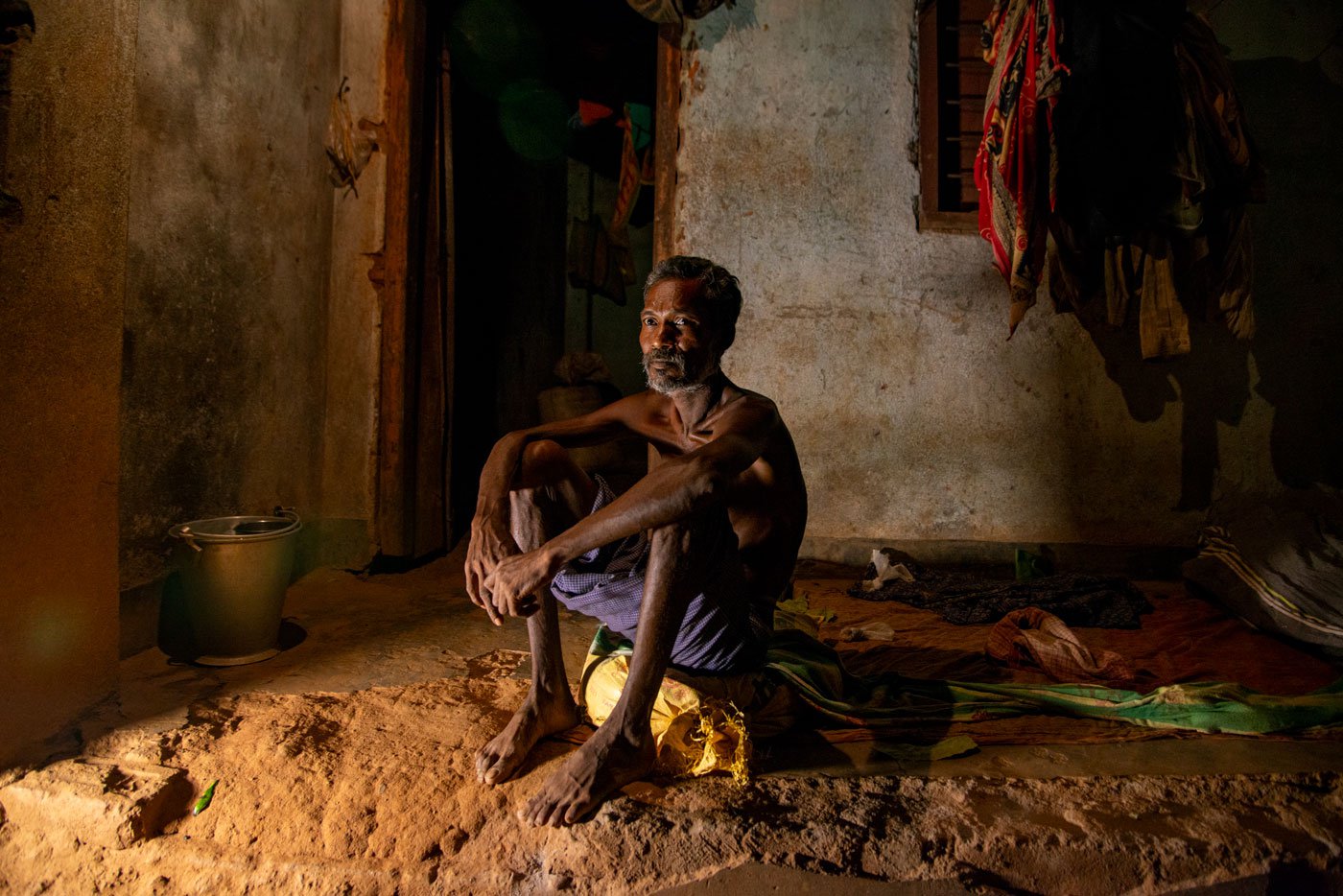
Karmu Nayak of Benashuli says he doesn't have the physical strength to go to the forest to gather leaves to sell and buy food
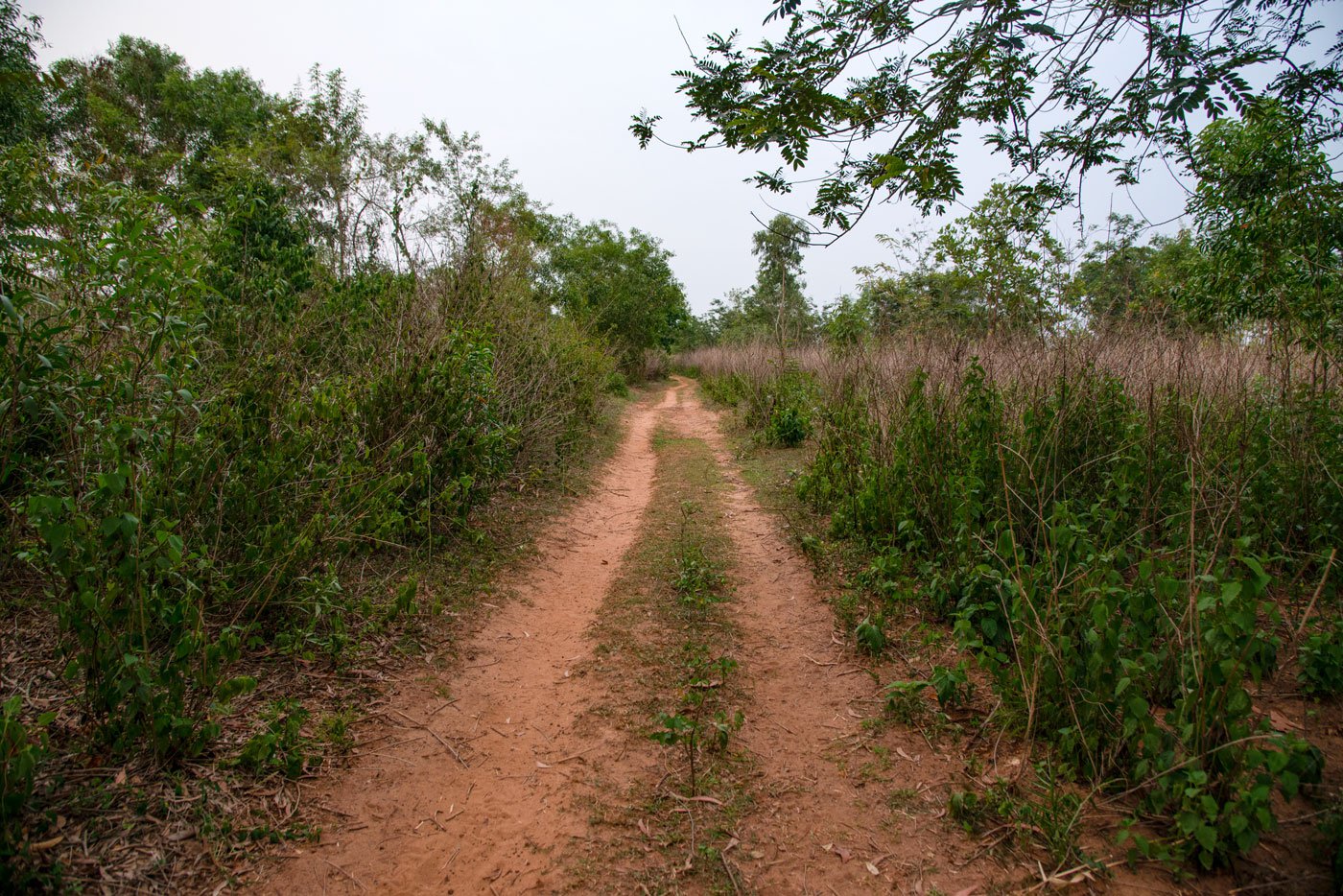
Most Sabar Adivasi villages are located deep inside forests of Jhargram, West Medinipur, Purulia and Bankura
